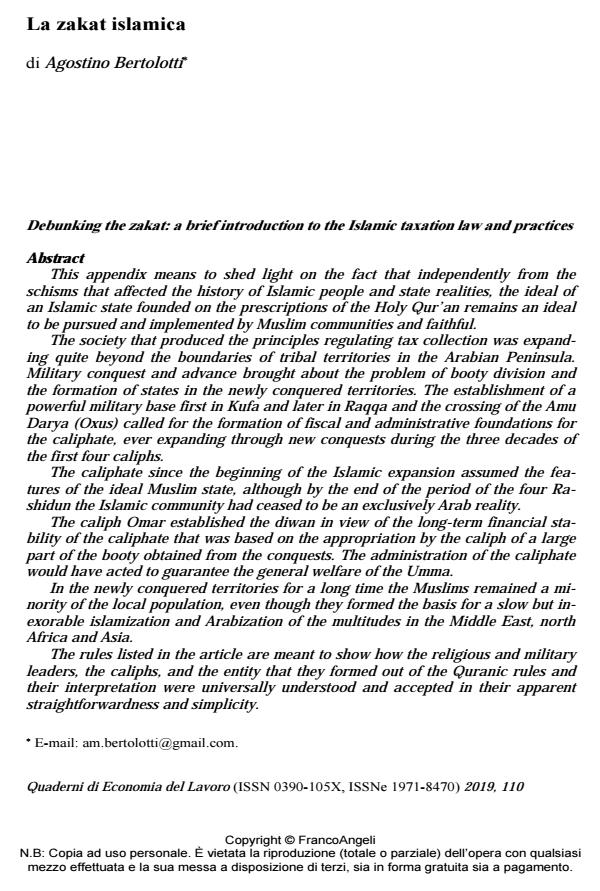Debunking the zakat: a brief introduction to the Islamic taxation law and prac-tices
Journal title QUADERNI DI ECONOMIA DEL LAVORO
Author/s Agostino Bertolotti
Publishing Year 2020 Issue 2019/110
Language Italian Pages 23 P. 183-205 File size 237 KB
DOI 10.3280/QUA2019-110009
DOI is like a bar code for intellectual property: to have more infomation
click here
Below, you can see the article first page
If you want to buy this article in PDF format, you can do it, following the instructions to buy download credits

FrancoAngeli is member of Publishers International Linking Association, Inc (PILA), a not-for-profit association which run the CrossRef service enabling links to and from online scholarly content.
This appendix means to shed light on the fact that independently from the schisms that affected the history of Islamic people and state realities, the ideal of an Islamic state founded on the prescriptions of the Holy Qur’an remains an ideal to be pursued and implemented by Muslim communities and faithful. The society that produced the principles regulating tax collection was ex-panding quite beyond the boundaries of tribal territories in the Arabian Peninsu-la. Military conquest and advance brought about the problem of booty division and the formation of states in the newly conquered territories. The establishment of a powerful military base first in Kufa and later in Raqqa and the crossing of the Amu Darya (Oxus) called for the formation of fiscal and administrative foun-dations for the caliphate, ever expanding through new conquests during the three decades of the first four caliphs. The caliphate since the beginning of the Islamic expansion assumed the features of the ideal Muslim state, although by the end of the period of the four Rashidun the Islamic community had ceased to be an exclusively Arab reality. The caliph Omar established the diwan in view of the long-term financial sta-bility of the caliphate that was based on the appropriation by the caliph of a large part of the booty obtained from the conquests. The administration of the ca-liphate would have acted to guarantee the general welfare of the Umma. In the newly conquered territories for a long time the Muslims remained a mi-nority of the local population, even though they formed the basis for a slow but inexorable islamization and Arabization of the multitudes in the Middle East, north Africa and Asia. The rules listed in the article are meant to show how the religious and military leaders, the caliphs, and the entity that they formed out of the Quranic rules and their interpretation were universally understood and accepted in their apparent straightforwardness and simplicity.
Keywords: Islamic tax system; taxable assets; social-economic redistribution and welfare; religious obligation; taxation customs and practices; caliphate
Agostino Bertolotti, La zakat islamica in "QUADERNI DI ECONOMIA DEL LAVORO" 110/2019, pp 183-205, DOI: 10.3280/QUA2019-110009